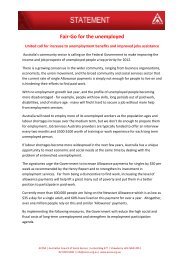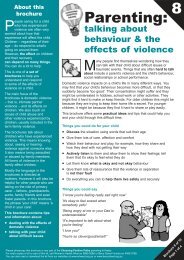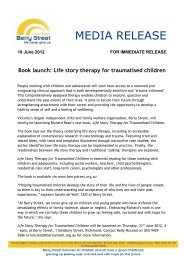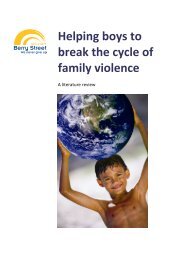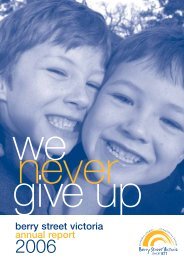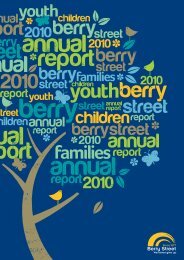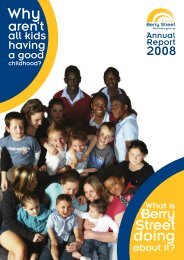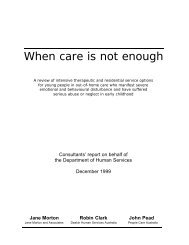Therapeutic foster care - Berry Street Childhood Institute
Therapeutic foster care - Berry Street Childhood Institute
Therapeutic foster care - Berry Street Childhood Institute
You also want an ePaper? Increase the reach of your titles
YUMPU automatically turns print PDFs into web optimized ePapers that Google loves.
planned and unplanned respite, <strong>foster</strong> parent support<br />
group, training for <strong>care</strong>rs (pre and ongoing), 24-hour<br />
crisis intervention, multifamily retreats, and an<br />
innovative 'step-down' program that prepares<br />
children to transition back home, with diminished<br />
clinical support.<br />
The goal of the program is for children to return to<br />
parents or permanency in 18-24 months. An<br />
innovative matching process is supported by creating<br />
videos for children to view prior to entering <strong>care</strong> of<br />
potential <strong>foster</strong> families.<br />
Outcome measures for the program include the Child<br />
and Adolescent Problem Checklist, administered pretreatment<br />
and every 6 months thereafter. The program<br />
outcomes appear promising with 74% of youths noted<br />
as improving significantly emotionally, 37% improved<br />
in school and 47% stabilised in school situation, with<br />
53% showing an improvement in behaviour.<br />
In an Australian context, further discussion and<br />
consultation with Aboriginal services is necessary to<br />
explore therapeutic <strong>care</strong> models that are more closely<br />
aligned to culturally appropriate and community<br />
orientated practice. The over-representation of<br />
Aboriginal children in the out of home <strong>care</strong> sector<br />
(DHS, 2003) demands that considerable attention be<br />
provided to exploring appropriate therapeutic<br />
models for Aboriginal children and their families. In<br />
doing so, acknowledgment needs to be given to the<br />
impact of past welfare policies (stolen generations)<br />
and how this contributes to the current tensions<br />
within the Aboriginal community to be associated<br />
with formal out of home <strong>care</strong> services, as the agencies<br />
involved may be the same ones or reminiscent of<br />
agencies implicated in the forced removal of<br />
Aboriginal children (Higgins et al., 2005).<br />
Furthermore, Higgins et al., (2005) write “a tension<br />
between a cultural commitment to community and an<br />
aversion to formal child welfare among Aboriginal and<br />
Torres Strait Islander peoples appears to be a fundamental<br />
issue in enhancing culturally appropriate placements for<br />
Indigenous children”.<br />
Effectiveness of therapeutic<br />
<strong>foster</strong> <strong>care</strong><br />
TFC effectiveness and cost-efficient benefits<br />
<strong>Therapeutic</strong> <strong>foster</strong> <strong>care</strong> is often touted as an effective<br />
treatment model for children with challenging<br />
behaviours in out of home <strong>care</strong>. Research on the<br />
efficacy of TFC has identified that:<br />
• The characteristics of children and youth served<br />
in TFC have similar problems to those in<br />
residential <strong>care</strong> which suggests it is a viable<br />
option for children and youth with emotional<br />
and behavioural difficulties to receive treatment<br />
and <strong>care</strong> in a family setting (Chamberlain, 2000).<br />
• Some studies have shown that Youth in TFC<br />
have shown better adjustment and outcomes<br />
than those children living in congregate <strong>care</strong><br />
programs (Chamberlain, 2000).<br />
• TFC has been shown to lead to higher rates of<br />
placement stability than regular <strong>foster</strong> <strong>care</strong>,<br />
despite serving a more challenging population<br />
of children and adolescents (Bryant, 2004).<br />
• A high proportion of children are discharged to<br />
less restrictive settings following a placement in<br />
TFC (Fanshel, 1990 as cited in Chamberlain,<br />
2000).<br />
• TFC is noted as cost-efficient, placing children<br />
who would otherwise be placed in residential<br />
<strong>care</strong> at half the cost or less (Bryant, 2004).<br />
Although the efficacy of TFC has typically been<br />
evaluated by quantitative measures (such as length of<br />
placement, number of placements, etc), recent<br />
research has called for inclusion of additional<br />
outcome measures to be explored. Redding and<br />
colleagues (2000, p. 428) note the limitations of<br />
previous quantitative research in TFC and state that,<br />
“Although these measures are valuable in measuring<br />
placement success, they do not provide adequate<br />
information regarding child and family functioning and<br />
adjustment, nor do they provide a systematic evaluation of<br />
placement satisfaction”. It should be noted that there is<br />
little research contributing long-term outcome data<br />
about outcomes for children in any kind of<br />
placement, whether that is traditional <strong>foster</strong><strong>care</strong>,<br />
therapeutic <strong>foster</strong><strong>care</strong> or residential <strong>care</strong>.<br />
In an effort to better define what TFC programs look<br />
like, one study has focused their evaluation on<br />
describing the programmatic and youth<br />
characteristics served by TFC (Hudson et al., 1994).<br />
Hudson and colleagues (1994) surveyed 321 TFC<br />
programs operating across America and Canada.<br />
Data from the survey were categorised by program<br />
characteristics, such as private/public status, annual<br />
program budgets, training provided to <strong>care</strong>rs,<br />
<strong>care</strong>giver requirements/attendance at support<br />
groups and training, involvement of parents,<br />
treatment approaches, caseload sizes and client<br />
characteristics (Hudson et al., 1994). Results indicated<br />
that the majority of programs were privately<br />
operated, and most required pre- and in-service<br />
training, compulsory attendance at <strong>care</strong>giver support<br />
groups and written treatment plans. A significant<br />
number of programs identified a preference for a<br />
behaviour modification treatment approach of 56%<br />
with only 26% choosing a systemic, contextual or<br />
ecological approach. The majority of children<br />
admitted into the programs were from residential<br />
settings and had psychiatric, behavioural or<br />
emotional problems. Approximately two-thirds of<br />
youth were aged 12-17 years and stayed, on average,<br />
a period of 13 months in TFC. Whilst it was not the<br />
intention of the survey to evaluate the 321 programs,<br />
it does provide a useful description of a number of<br />
TFC program characteristics and youth served.<br />
24 <strong>Therapeutic</strong> Foster Care



